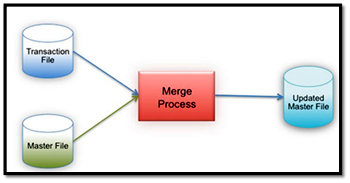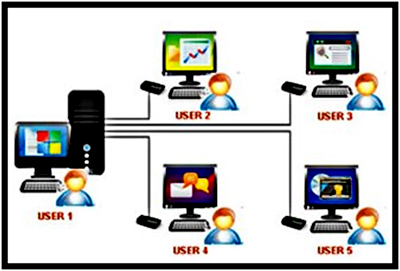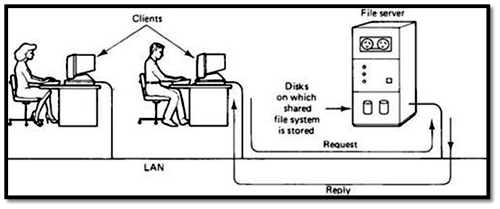Types of operating system
Sakshi Education
Operating systems are classified based on the application domain.
There are different types of operating system:


- Single or serial processing operating systems
- Batch Processing
- Real-time operating system
- Multi-user operating system
- Multi-tasking operating system
- Distributed operating system
- Templated operating system
- Single or serial processing operating systems:
These operating systems perform one job at an instance in a sequence manner. This works on the principle of queue, i.e., First In First Out (FIFO).The instructions to be executed into the queue waiting for their turn. The Program Counter is used to determine, which instruction is going to be executed and responsible for executing all the Instructions. This sort of operating system is not in use in recent times, this was used in the era of punch cards, where the users are supposed to enter all their jobs in to punch cards and then computer processes them.
- Batch Processing:
 In batch operating system, tasks that have similar need are batched together and executed by the computer. Jobs sequencer handles the job of processing each job. This type of operating system enhances the performance of the CPU, as the CPU and devices are set no free at any point of time with: buffering, off-line operation, spooling, and multi-programming task. Batch systems find their best at the times of executing larger jobs that requires little interaction.
In batch operating system, tasks that have similar need are batched together and executed by the computer. Jobs sequencer handles the job of processing each job. This type of operating system enhances the performance of the CPU, as the CPU and devices are set no free at any point of time with: buffering, off-line operation, spooling, and multi-programming task. Batch systems find their best at the times of executing larger jobs that requires little interaction.
Advantages:
- It can shift the time of job processing to when the computing resources are less busy.
- It avoids idle time of computing resources with minute-by-minute manual intervention and supervision.
- By keeping high overall rate of utilization, it amortizes the computer, especially an expensive one.
- It allows the system to use different priorities for interactive and non-interactive work.
- Reduces systems overhead by running the program only once for many transactions, reducing system overhead.
- Real time operating system (RTOS):
The supervision of the embedded application s/w and providing mechanisms to the processor for better clock per cycle utilization is achieved by the mechanism called as “Real time operating system (RTOS)”. It provides algorithms to perform context switching between various processes (tasks). It organizes access to a resource in sequence of the series of tasks of the system.
Eg of RTOS: LynxOS, OSE, QNX, RTLinux, VxWorks, Windows CE, Free RTOS, etc.
RTOS is of two types:
- Hard real time system
- Soft real time system
Whereas Soft real time are not time bounded systems. Delay in task execution is of not much importance. Rather it focuses on sequence for the task-operations. EX: Toys, Mobile phones...
- Multi-user operating system
An operating system that allows various other computer systems to access the resources of one computer system is termed as Multi-User Operating system. Servers are the best examples for this sort of systems, where many remote users communicate with the server system and get their tasks done. Time sharing systems are the best example for multiuser operating systems. Some multi user systems allows one system to place their request, up on completion of the task only then access will be granted to another system, whereas few systems allow multiple users simultaneously access the resources(Eg: Windows NT).Eg: Concurrent DOS, Multiuser DOS, FlexOS, UNIX, WindowsNT, etc..
Figure: Multi-user operating systems
- Multi-tasking operating systems
Multitasking in terms computing is an act in which the computer executes various tasks concurrently during the same time period. The operating system that facilitates this act is termed as multitasking operating system. Here the tasks share the same time space and CPU space. Here the task will be performed until the new task preempts the processor or it waits for the resources like some input device to respond. This wait kills the processor time, so as to make the effective utilization of the processor, during the wait time the processor will be instructed to serve another task till the previous task is done with its wait time. If the wait time continues, the processor will keep on executing task, say even this task too requires some wait then the processor will be instructed to address another task which needs the service. Apart from this even in the case of high priority task call, the processor holds the current execution. This, to human perception appears to be multitasking due to faster switching times.
Below figure demonstrates the above explanation with three programs A, B& C, being multitasked.

The task keeps running until it performs an operation that requires waiting for an external event (e.g. reading from a tape) or until the computer's scheduler forcibly swaps the running task out of the CPU. Multiprogramming systems are designed to maximize CPU usage.
- Distributed operating system:
Distributed operating system concept can be best understood in the words of various experts as follows:
- “A distributed system is a collection of independent computers that appear to the users of the system as a single computer.”- Coulouris
- A distributed system is a collection of independent computers that appear to the users of the system as a single computer.” -Tanenbaum
- “A distributed system consists of a collection of autonomous computers linked to a computer network and equipped with distributed system software.”
- “A distributed system is a collection of processors that do not share memory or a clock.”
- “Distributed systems is a term used to define a wide range of computer systems from a weakly-coupled system such as wide area networks, to very strongly coupled systems such as multiprocessor systems.”
The biggest challenge in distributed operating system comes with the security as all the systems are connected across the network it is more open to attacks.

- Templated operating system
This sort of system is usually employed in case of cloud and distributed environment. In this sort of operating system, an operating creates a virtual machine image for guest computer and this serves a source to operate multiple virtual machines.
Published date : 01 Jan 2015 04:11PM






